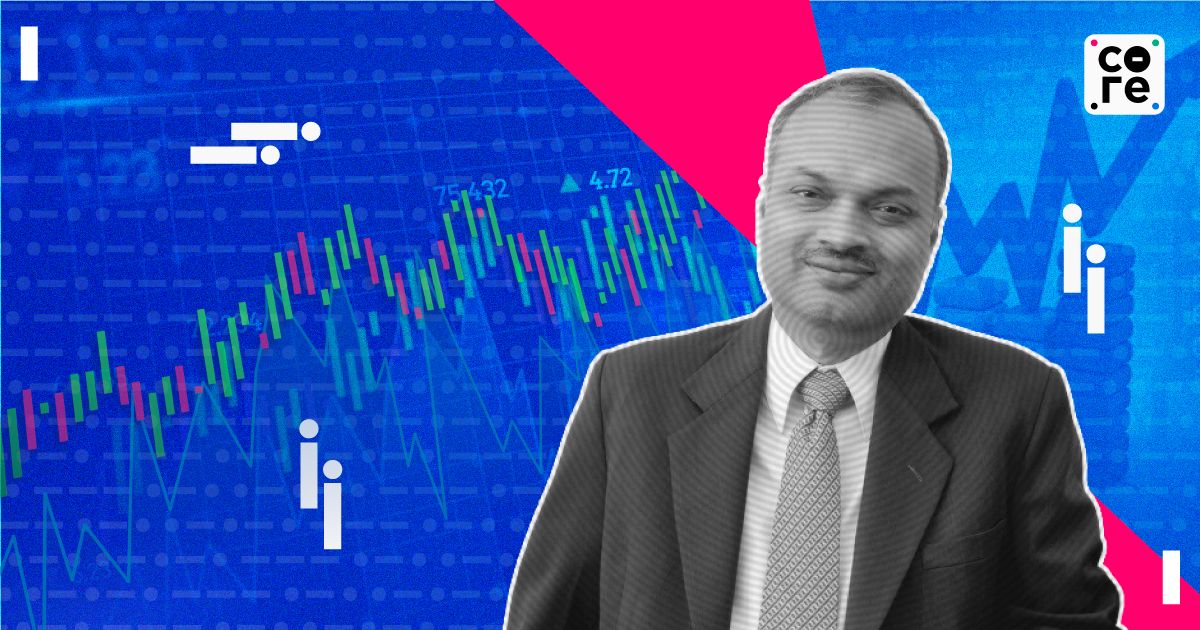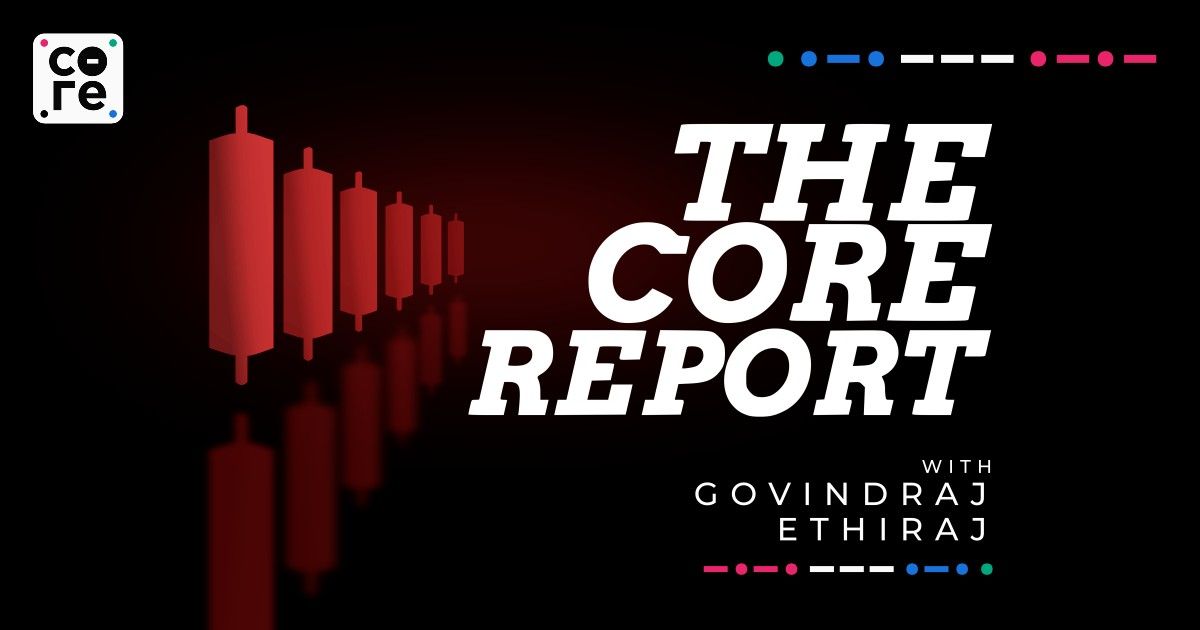On Episode 275 of The Core Report, financial journalist Govindraj Ethiraj, talks to Siddharth Pai, a technology research consultant and Founder & Managing Partner at Siana Capital (a venture firm) as well as economic journalist and author Puja Mehra.
Our Top Reports For Today
- (00:00) Stories Of The Day
- (01:00) Markets And Oil Recover From Middle East Tensions, All Eyes On Earnings
- (07:07) Insurance Companies Will Now Offer Health Coverage For Pre-Existing Conditions Like Cancer As Well, Age Limit Of 65 Years Removed
- (08:41) What Exactly Is Going On With Elon Musk’s India Investment
- (13:10) Indian IT’s Falling Headcounts. What They Really Mean And Why The Prognosis Is Grim
- (25:50) Why A Policy To Offer Free Bus Rides To Women May Not Have The Desired Effect
NOTE: This transcript contains only the host’s monologue and does not include any interviews or discussions that might be within the podcast. Please refer to the episode audio if you wish to quote the people interviewed. Email [email protected] for any queries.
—
Markets Recover from Middle East Tensions, As Does Oil, In Brighter Outlook For Week
So the good news is that Friday last week saw the markets pull back after falling steadily for most of the week.
The immediate triggers were the Iran-Israel conflict which looked and perhaps still does, all set to become something bigger. A minute or two on this important subject.
As expected, at least on The Core Report, Israel retaliated on Friday against Iran’s firing of some 200 missiles into Israel which in turn was a retaliation for Israel bombing Iran’s consulate in Syria.
Israel fired into some Iranian cities but Iranian media itself showed visuals suggesting all was quiet.
AP reported authorities saying air defences fired at a major air base near Isfahan, which long has been home to Iran’s fleet of American-made F-14 Tomcats — purchased before the 1979 Islamic Revolution.
Isfahan also is home to sites associated with Iran’s nuclear program, including its underground Natanz enrichment site, which has been repeatedly targeted by suspected Israeli sabotage attacks.
State television described all Iranian atomic sites in the areas as “fully safe.” The United Nations’ nuclear watchdog, the International Atomic Energy Agency, also said there was “no damage” to Iran’s nuclear sites.
Iranian officials made no mention of possible Israeli involvement. Israel also had no comment on the apparent attack except one hard-line government minister, Itamar Ben-Gvir, hinted at his dissatisfaction, reported AP.
The back-room lobbying and pressure building is evidently extremely intense because both sides in some ways downplayed their actions and promised, at least on the back-channel, not to push things further since the hawks itching for war were seemingly placated for now.
What that means is that oil prices have fallen quite sharply. And more on that shortly.
The key trends to watch in Indian stock markets, if there are no flare ups elsewhere, will be earnings and flows.
There are expectedly no surprises on earnings for both HDFC Bank and Wipro among others, both of which reported muted results.
HDFC Bank which reported a 2.11% growth in consolidated net profits to rs 17,622 crore for March 2024.
Overall, the BSE Sensex declined 1,156.57 points or 1.55 per cent and the Nifty dipped 372.4 points or 1.65 per cent last week.
Moneycontrol said some 160 companies will release quarterly earnings this week including names like Reliance Industries, Tata Consumer Products, Axis Bank, Hindustan Unilever, LTIMindtree, Bajaj Finance, HCL Tech, Maruti Suzuki India and ICICI Bank.
There are many more since earnings now come fairly bunched up. And in most cases, the companies are closely tracked so surprises in any direction are minor.
The worrying factor is that foreign institutional investors are continuing to sell India. FIIs net sold Rs 11,867 crore worth of stocks in the cash segment last week, taking the total monthly outflow to Rs 22,229 crore thus far in April.
The buying is coming from, like before, DIIs.
While high interest rates in the US are pulling back funds, the trend reversal is noteworthy since the buying had picked up only this year after heavy selling last year.
Bloomberg reported last week that global funds are retreating from emerging markets in Asia, with a five-month buying spree of stocks ending on scaled-down expectations for US rate cuts. This excluded China. That will snap the longest streak of purchases going back to 2017.
And Oil Prices Are Down Again
Oil prices seem to be responding quite swiftly to risk sentiment shifts, notably in the middle east now. Or another way of looking at it is, that demand signals are so low that prices drop the moment the risk perception eases.
Bloomberg reported an analyst from Rystad Energy saying their analysis suggests a fair market value of $83 per barrel based on fundamentals, indicating a current premium attributable to geopolitical concerns.
Brent crude was quoting at $87.29 a barrel over the weekend and has rallied around 13% this year, with gains driven by the worsening hostilities in the Middle East, as well as OPEC supply cuts that have tightened the market.
Gold And China
You can, for what it’s worth, blame China for gold prices going where they are.
We have of course been discussing how China is steadily buying up gold and contributing to gold’s price going to all-time highs above $2,400 an ounce this year.
But there are some other interesting things about China and gold you may not have noticed.
For one, China is still the world’s biggest producer and consumer of the precious metal.
Second, it’s not just China’s central bank which is buying gold but also retail shoppers, fund investors and futures traders.
The reason, very broadly of course uncertain times and a move away from the dollar.
The interesting thing is that China and India are usually competing for the title of the world’s largest buyer.
But last year, as Bloomberg reports, China’s gold gold jewellery demand rose 10% while India’s fell 6%.
Moreover, in the last two years, China’s overseas purchases totaled over 2,800 tons — more than all of the metal that backs exchange-traded funds around the world, or about a third of the stockpiles held by the US Federal Reserve.
It shows no signs of slowing down. In the first two months of 2024, gold imports in China were 53% higher than they were in 2023. And the central bank, the People’s Bank of China has been on a buying spree for 17 straight months, its longest-ever run of purchases.
All this suggests of course that prices are likely to remain steady to edge higher in coming months though within India there seems to be a slackening of demand with prices over Rs 74,000 per 10 gm.
The other thing is that while jewellery demand may slow a little, investment demand could be strong, which could also come via ETFs and the like.
IRDA Removes 65 Years Limit And Pre Existing Condition Limitation
This is welcome news to many of us with older parents or older people who have searched for but found it difficult to get insurance as they get older.
India’s insurance regulator has removed the age limit of 65 years for individuals buying health insurance policies.
Earlier, individuals could not get comprehensive coverage.
However, with the recent amendment, which has been effective from April 1, anyone, regardless of age, is eligible to buy a new health insurance policy.
Moreover, insurers have been mandated to offer health policies to individuals with pre-existing medical conditions of any kind and cannot refuse insurance just because someone has had cancer, heart or renal failure, and AIDS.
Moreover, insurers can now collect premium payments, which would obviously be high in such cases, in instalments for the convenience of policyholders.
There is no limit on AYUSH treatment coverage. Treatments under systems like Ayurveda, Yoga, Naturopathy, Unani, Siddha, and Homeopathy will receive coverage up to the sum insured without any cap, it said.
Policyholders with benefit-based policies can file multiple claims with various insurers, enhancing flexibility and options, it said.
The proposed regulation seeks to handle the complaints and claims of senior citizens via a specialised channel, ensuring a more tailored and responsive approach to their requirements, it added.
The Tesla Mystery Deepens
The market for your key product is slowing down. Your share price is tanking. You have other problems, many self created of course, apart from the fact that you run six companies.
So at a time like this, do you go and expand into a new, smaller market albeit with solid long term potential or first double down and fix the problem at hand.
Until the weekend, it appeared like Elon Musk was doing just that, set to announce new manufacturing investments in India, speculated by wire agencies like Reuters to be in the region of $2 to $3 billion and not doing much to tackle the fire burning at home.
And then Musk announced the postponement of a much hyped up and planned trip to India where he was to meet Prime Minister Narendra Modi, citing obligations at his Tesla automaker and saying he aimed to reschedule the visit for later this year.
“Unfortunately, very heavy Tesla obligations require that the visit to India be delayed, but I do very much look forward to visiting later this year,” Musk posted on his X social media platform.
So before I come back to the India part, let us look at what has been going on with Tesla.
Tesla, as we have been pointing out over several months in The Core Report, has been losing ground.
To be fair, this may not be just Tesla’s problem but one of slowing down of EV adoption, particularly in developed markets.
The company has already reported vehicle deliveries that have missed estimates by a wide margin. The stock has fallen more than 40% this year, dropping the automaker’s market value to less than $470 billion.
Right now, it is cutting prices elsewhere, something auto makers usually do if pushed against the wall.
Tesla has now cut prices of its models across China, Europe and the US amid slumping sales and a glut of inventory.
The company also slashed the price of the driver assistance software that it calls FSD, or Full Self-Driving, by a third to $8,000 in the US. It had been $12,000.
Why?
Because the promise of a fully autonomous vehicle has long been key to Tesla’s lofty valuation, says Bloomberg.
A robotaxi is apparently going to be unveiled on Aug. 8.
Now, in India, going by all the faithfully reported reports, Tesla was going to launch a low cost EV in India and would manufacture one soon.
We were told the EV would cost around Rs 20 Lakh. By the way, that announcement was supposed to happen at the Vibrant Gujarat summit in the second week of January 2024.
So this is the second time Musk has ditched, though the first one was not finalised and was more in the nature of selective leaks and rumours.
Back to now, Musk was expected to announce an investment of $2 billion to $3 billion, mainly to build a factory in India, after the government announced a policy lowering high tariffs on imported cars if companies invest locally, Reuters has reported.
Now, here is where the story gets interesting.
On April 6, Reuters reported that Tesla has now junked plans to make low cost EVs because of fierce competition from Chinese EV companies, who are pricing below $10,000. The report was sort of denied by Musk but without any specific references.
Moreover, a key Tesla official of Indian origin Rohan Patel, who was a senior public policy and business development official, has quit as of last week, along with another senior Tesla official.
Interestingly, in 2023, Patel led the talks with the Government of India on setting up base in India and also spoke of, going by reports, a $24,000 EV car which on the face of it is less than Rs 20 Lakh.
Now, with Patel gone and Tesla’s likely intent to scrap the cheaper EV, it is not clear what the India opportunity is, at least as far as EVs go.
Of course, Tesla can still come in, first via cheaper imports, a policy concession it managed to wrangle against all odds and then via local manufacturing which is mandated.
But this would mostly be high priced cars thus competing with the electrics of the high end BMWs, Audis and Kias.
Of course there is a market there too and Tesla might do well but the numbers would then be in the 1000s per year.
Not something that is worth such a song and dance.
And by the way, BMW is doing quite well in EVs on the premium end, particularly in Europe, against the likes of Tesla. There is no reason it can’t do the same in other markets like India.
Meanwhile, I did wonder why Tesla is not going ahead with its $2-3 billion dollar investment. Musk does not have to visit India for that.
Shipment of cars can start in months perhaps, showrooms, going by Reuters again, are already being explored in Mumbai and Delhi so things can start moving in earnest.
Of course that does not seem to be the case, for now.
Falling Headcount In Indian IT
Last week, we touched upon how headcount in Indian IT Services companies is falling consistently.
The impact of this is a little broader since this segment of youth employment is a key driver in consumption, both present and potential.
What are the signs looking like ? Before I come to that, let’s take some of the major companies.
India’s largest IT company Tata Consultancy Services (TCS) reported a 601,546 as of March 2024, a drop of 13,249 employees from the same period last year. Infosys said its headcount dropped by around 26,000 to 317,240 as of March 2024, while Wipro too saw a decline by around 24,516 employees in FY24 on an annual basis.
In total, the three leading IT companies saw a reduction of nearly 64,000 employees in FY24 on an annual basis.
This was the first time this has happened for Infosys and TCS.
So the numbers may seem small and perhaps are but the trend reversal is significant.
If you look at revenue projections which are in the region of 1% for Infosys and Wipro, or lower, then it stands to reason that headcounts will keep dropping, if nothing else because companies will try to protect margins. After all, the main cost is people.
I reached out to Sidharth Pai, who has tracked India’s IT services industry closely as a technology research consultant and now founder & Managing Partner, Siana Capital, a venture firm and began by asking him why headcounts were falling and what it meant in a larger context.
—
Why Free Bus Rides For Women May Not Have The Desired Effect
A move to introduce discounted or free rides for women in buses has been welcomed and celebrated even.
But do they work?
The reasons why they do and don’t have to do with a larger understanding of how economics works and why there is a give for every take.
Economics journalist and author Puja Mehra kicks off a new show on the Core Report called How India’s Economy Works where she delves into issues around India’s economic policies with the people who shape them.
Tune in for the first episode with Dr Haseeb Drabu, economist and former finance minister of Jammu and Kashmir and many others to follow.
—





